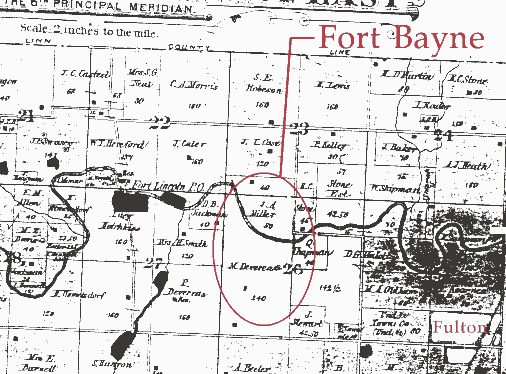
...sometimes referred to as Fort Bain, appears to have consisted of one large log house, built by Oliver P. Baynes of Ohio. He and his wife, Mahala, are listed on the Bourbon County census of 1860, as living with their two sons, Roberts H. and Adolphus G.

The fort was constructed by Bayne just shortly after he received his claim in the spring 1857. John Brown assisted with Bayne with the construction, and Brown later built a rude defensive structure 200 yards south of Bayne's fort for his own use. In 1858, this complex became known as Fort Bayne.
Bayne was a strong Free-State leader, a brawny, muscular man with a broad forehead. He was considered careless but good-natured. His sunburnt, bearded face indicated that he was an outdoorsman. He was known to be completely faithful to James Montgomery, chief of the Jayhawkers.
Fort Bayne was the site of several significant, notorious incidents during the Border War period of Kansas history.
Nov. 1857- "Squatter's Court" held at Fort Bayne. Free-Staters, including Bayne and Brown, organized their own court in response to legal pro-slave court of Judge Williams which settled land claims. Williams sent a posse of 200 pro-slave men, under the direction of Marshall Little, to break up the squatter's court. Free-staters, anticipating retaliatory action, had already sent for help. James Abbot, radical Free-Stater from Lawrence; William Phillips, correspondent for the New York Tribune; James Montgomery, and 45 of his men; James G. Blunt, later General Blunt- commander of the Union forces and ten others from Greeley, were waiting at Fort Baynes when the posse arrived.
An hour-long battle ensured. A "recollection" of the battle, by a neighbor of Bayne, is kept at the Osaga Historical Society in Fulton.
Dec. 7, 1858- Montgomery and Brown, and about 100 other free-staters from Lawrence, Emporia, and Osawatomie met at Bayne's to make a raid on Fort Scott to liberate a Free-Stater Benjamin Rice, who was held in Fort Scott for the murder of a Pro-Slaver. A disagreement over who should lead the raid to free Rice ensued, and Montgomery took the lead. Brown, with a handful of men, stayed behind at Bayne's fort. During the raid, John Henry Kagi was wounded.
Dec. 19, 1858- According to several history books, "Jim," a Missouri slave, visited Fort Bayne, attempting to gain assistance in securing the freedom of himself, his wife, and his children. He was sent back to his master, with the promise that some action would be taken. A day later, Brown and Kagi led a raid into Missouri and freed 11 slaves. During at least one of their first days of freedom, Fort Bayne offered shelter at night.
Records indicate that Fort Bayne was located on the north side of the Osage River, 1 1/2 miles due east of Fort Lincoln, about 1 mile west of the northwest city limits of Fulton.
This site, a ford on the Osage River, was also known as the place where some of General Sterling Price's men crossed the river in 1864, following the Battle of Mine Creek. Price's men killed a farmer as they crossed the river at Fort Bayne.
More information is available at the Osage Historical Society, located in the old St. Patrick's Catholic Church in Fulton. Contact Jean Schmelzla at (316) 857-4824 or Velma Nickerson at (316) 857-4777 or Marie Arbogast.